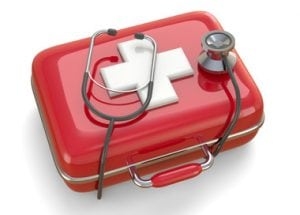The Occupational Safety and Health Act provides guidance and information on developing effective first-aid arrangements for every workplace. The purpose is to minimize the consequence of injury or illness until the services of a practitioner or nurse are obtained. For minor injuries, your first-aid kit may be enough.
OSHA sets standards for the minimal acceptable number and type of supplies for first-aid kits. The contents should be adequate for small worksites with two or three employees. For larger operations with multiple departments, kits need to be spread around. In businesses like restaurants, where sharp knives and hot ranges are the norm, sufficient first-aid kits are essential.
Here’s what an OSHA first-aid kit should contain:
- 4-by-4-inch gauze pads.
- At least two 8-by-10-inch gauze pads.
- Boxed adhesive bandages, otherwise known as Band-Aids.

- A package of gauze roller bandage that are at least two inches wide.
- Two triangular bandages.
- A wound-cleaning agent — can be a moistened towelette.
- Scissors.
- At least one blanket.
- Tweezers.
- Adhesive tape.
- Latex gloves.
- Resuscitation bag, airway or pocket mask.
- Two elastic wraps.
- Splint.
- Directions for requesting emergency assistance.
Other recommended contents include:
- Sterile eye pads with bandage attached.
- Individually wrapped disinfectant wipes.
- Sterile water.
There are no exemptions based on a company’s size — all industries are required to comply regardless of the type of work performed. Your first-aid program needs to correspond to the hazards that can be reasonably expected to occur.
Should you anticipate that employees will be exposed to blood or other potentially infectious materials while using first-aid supplies, you need to provide personal protective equipment. Exceeding guidelines for general industry, construction and industry-specific first-aid requirements is wise. There are OSHA-compliant first-aid kits on the market specifically designed for myriad fields — an internet search brings up first-aid kits for commercial and fleet vehicles, truckers, restaurants, landscapers, pools and lifeguards, welders, loggers, contractors and construction.
In factories, clearly hard hats, gloves and safety vests are de rigueur. You also need to provide protection to rescuers. Therefore, next to each first-aid kit, you should have a bodily fluid pickup kit with eye and hand protection, fluid absorbents, sanitizing and disposal products, and a CPR mask. Some manufacturers prepackage these with first-aid kits and sell them as OSHA compliance packages.
And don’t forget automated external defibrillators — AED availability in the workplace goes a long way toward meeting your OSHA first-aid response requirements.
Train your staff in first aid. Rare is the operation with no life-threatening potential. Cases have been filed alleging negligence in office situations — slips, trips and falls, as well as environmental hazards. Training is inexpensive and can be offered on a company-paid or voluntary basis, providing the opportunity for improved employee morale and seen as an employment benefit. This training should include CPR. Public nonprofit groups offer certifications that are usually valid for two years.
Don’t wait until you have an accident, inspection or citation. Equip your facility with adequate and appropriate first-aid and safety equipment. Schedule some fun and inexpensive lifesaving training for your staff. OSHA compliance can be easy and affordable.
|
Copyright © IndustryNewsletters All rights reserved.
|


Recent Comments